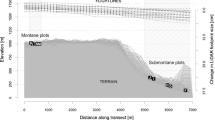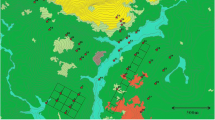Abstract
Airborne light detection and ranging (LiDAR) is fast turning the corner from demonstration technology to a key tool for assessing carbon stocks in tropical forests. With its ability to penetrate tropical forest canopies and detect three-dimensional forest structure, LiDAR may prove to be a major component of international strategies to measure and account for carbon emissions from and uptake by tropical forests. To date, however, basic ecological information such as height–diameter allometry and stand-level wood density have not been mechanistically incorporated into methods for mapping forest carbon at regional and global scales. A better incorporation of these structural patterns in forests may reduce the considerable time needed to calibrate airborne data with ground-based forest inventory plots, which presently necessitate exhaustive measurements of tree diameters and heights, as well as tree identifications for wood density estimation. Here, we develop a new approach that can facilitate rapid LiDAR calibration with minimal field data. Throughout four tropical regions (Panama, Peru, Madagascar, and Hawaii), we were able to predict aboveground carbon density estimated in field inventory plots using a single universal LiDAR model (r 2 = 0.80, RMSE = 27.6 Mg C ha−1). This model is comparable in predictive power to locally calibrated models, but relies on limited inputs of basal area and wood density information for a given region, rather than on traditional plot inventories. With this approach, we propose to radically decrease the time required to calibrate airborne LiDAR data and thus increase the output of high-resolution carbon maps, supporting tropical forest conservation and climate mitigation policy.








Similar content being viewed by others
References
Abshire JB et al (2005) The geoscience laser altimeter system (GLAS) on the ICESat mission: on-orbit measurement performance. Geophys Res Lett 32:L21S02
Asner GP (2009) Tropical forest carbon assessment: integrating satellite and airborne mapping approaches. Environ Res Lett 3:1748–9326
Asner GP, Palace M, Keller M, Pereira R, Silva JNM, Zweede JC (2002) Estimating canopy structure in an Amazon forest from laser range finder and IKONOS satellite observations. Biotropica 34:483–492
Asner GP et al (2007) Carnegie Airborne Observatory: in-flight fusion of hyperspectral imaging and waveform light detection and ranging (LiDAR) for three-dimensional studies of ecosystems. J Appl Remote Sens 1:013536. doi:10.1117/1111.2794018
Asner GP, Hughes RF, Varga TA, Knapp DE, Kennedy-Bowdoin T (2009) Environmental and biotic controls over aboveground biomass throughout a tropical rain forest. Ecosystems 12:261–278
Asner GP et al (2010) High-resolution forest carbon stocks and emissions in the Amazon. Proc Natl Acad Sci USA 107:16738–16742
Asner GP et al (2011a) High-resolution carbon mapping on the million-hectare Island of Hawaii. Frontiers Ecol Environ 9:434–439. doi:10.1890/100179
Asner GP et al (2011b) Multi-scale analysis of aboveground carbon storage in Madagascar. Biogeosciences (in review)
Baker PJ, Wilson JS (2000) A quantitative technique for the identification of canopy stratification in tropical and temperate forests. For Ecol Manag 127:77–86
Baker TR et al (2004) Variation in wood density determines spatial patterns in Amazonia forest biomass. Glob Change Biol 10:545–562
Baskerville G (1972) Use of logarithmic regression in the estimation of plant biomass. Can J For Res 2:49–53
Breugel MV, Ransijn J, Craven D, Bongers F, Hall JS (2011) Estimating carbon stock in secondary forests: decisions and uncertainties associated with allometric biomass models. For Ecol Manag 262:1648–1657
Brokaw NVL (1985) Treefalls, regrowth, and community structure in tropical forests. In: Pickett STA, White PS (eds) The ecology of natural disturbance and patch dynamics. Academic, New York, pp 53–69
Chave J et al (2005) Tree allometry and improved estimation of carbon stocks and balance in tropical forests. Oecologia 145:87–99
Chave J, Muller-Landau HC, Baker TR, Easdale TA, ter Steege H, Webb CO (2006) Regional and phylogenetic variation of woody density across 2456 Neotropical tree species. Ecol Appl 16:2356–2367
Chave J et al (2008) Assessing evidence for a pervasive alteration in tropical tree communities. PLoS Biol 6:e45
Chave J, Coomes D, Jansen S, Lewis SL, Swenson NG, Zanne AE (2009) Towards a worldwide wood economics spectrum. Ecol Lett 12:351–366
Clark DB, Read JM, Clark ML, Cruz AM, Dotti MF, Clark DA (2004) Application of 1-m and 4-m resolution satellite data to ecological studies of tropical rain forests. Ecol Appl 14:61–74
Drake JB, Dubayah RO, Knox RG, Clark DB, Blair JB (2002) Sensitivity of large-footprint lidar to canopy structure and biomass in a neotropical rainforest. Remote Sens Environ 81:378–392
Drake JB et al (2003) Aboveground biomass estimation in closed canopy neotropical forests using lidar remote sensing: factors affecting the generality of relationships. Glob Ecol Biogeogr 12:147–159
Enquist M, Arak A (1994) Symmetry, beauty and evolution. Nature 372:169–172
Feldpausch TR et al (2010) Height–diameter allometry of tropical forest trees. Biogeosci Discuss 7:7727–7793
Ganzhorn JU, Lowry PP, Schatz GE, Sommer S (2001) The biodiversity of Madagascar: one of the world’s hottest hotspots on its way out. Oryx 35:346–348
Gentry AH (1988) Changes in plant community diversity and floristic composition on environmental and geographical gradients. Ann Mo Bot Gard 75:1–34
Herold M, Skutsch M (2011) Monitoring, reporting and verification for national REDD + programmes: two proposals. Environ Res Lett 6:014002
IPCC (2006) Guidelines for national greenhouse gas inventories. IPCC National Greenhouse Gas Inventories Programme/Institute for Global Environmental Strategies, Hayama
Kalliovirta J, Laasasenaho J, Kangas A (2005) Evaluation of the laser-relascope. For Ecol Manag 204:181–194
Kellner JR, Asner GP (2009) Convergent structural responses of tropical forests to diverse disturbance regimes. Ecol Lett 12:887–897
King DA, Davies SJ, Nur Supardi MN, Tan S (2005) Tree growth is related to light interception and wood density in two mixed dipterocarp forests of Malaysia. Funct Ecol 19:445–453
Kitajima K, Mulkey SS, Wright SJ (2005) Variation in crown light utilization characteristics among tropical canopy trees. Ann Bot 95:535–547
Larjavaara M, Muller-Landau HC (2010) Rethinking the value of high wood density. Funct Ecol 24:701–705
Lefsky MA, Cohen WB, Acker SA, Parker GG, Spies TA, Harding D (1999a) Lidar remote sensing of the canopy structure and biophysical properties of Douglas-fir western hemlock forests. Remote Sens Environ 70:339–361
Lefsky MA, Harding D, Cohen WB, Parker G, Shugart HH (1999b) Surface lidar remote sensing of basal area and biomass in deciduous forests of eastern Maryland, USA. Remote Sens Environ 67:83–98
Lefsky MA, Cohen WB, Harding DJ, Parker GG, Acker SA, Gower ST (2002a) Lidar remote sensing of above-ground biomass in three biomes. Glob Ecol Biogeogr 11:393–399
Lefsky MA, Cohen WB, Parker GG, Harding DJ (2002b) Lidar remote sensing for ecosystem studies. Bioscience 52:19–30
Lefsky MA et al (2005) Estimates of forest canopy height and aboveground biomass using ICESat. Geophys Res Lett 32:L22S02. doi:10.1029/2005GL023971
Leigh EG Jr, Rand AS, Windsor DM (1982) The ecology of a tropical forest: seasonal rhythms and long term changes. Smithsonian Institution Press, Washington, DC
Mascaro J, Becklund KK, Hughes RF, Schnitzer SA (2008) Limited native plant regeneration in novel, exotic-dominated forests on Hawai’i. For Ecol Manag 256:593–606
Mascaro J, Asner GP, Muller-Landau HC, van Breugal M, Hall J, Dahlin K (2011a) Controls over aboveground forest carbon density on Barro Colorado Island, Panama. Biogeosciences 8:1615–1629
Mascaro J, Detto M, Asner GP, Muller-Landau HC (2011b) Evaluating uncertainty in mapping carbon with airborne LiDAR. Remote Sens Environ. doi:10.1016/j.rse.2011.07.019
Means JE et al (1999) Use of large-footprint scanning airborne lidar to estimate forest stand characteristics in the Western Cascades of Oregon. Remote Sens Environ 67:298–308
Niklas KJ (2006) A phyletic perspective on the allometry of plant biomass-partitioning patterns and functionally equivalent organ-categories. New Phytol 171:27–40
Popescu SC, Wynne RH, Scrivani JA (2004) Fusion of small-footprint lidar and multispectral data to estimate plot-level volume and biomass in deciduous and pine forests in Virginia, USA. For Sci 50:551–565
Reyes G, Brown S, Chapman J, Lugo AE (1992) Wood densities of tropical tree species. USDA Forest Service, New Orleans, p 18
Richards PW (1952) The tropical rainforest. Cambridge University Press, Cambridge
Richards P, Williamson GB (1975) Treefalls and patterns of understory species in a wet lowland tropical forest. Ecology 56:1226–1229
Schimel DS (1995) Terrestrial ecosystems and the carbon cycle. Glob Change Biol 1:77–91
Schnitzer SA, Bongers F (2011) Increasing liana abundance and biomass in tropical forests: emerging patterns and putative mechanisms. Ecol Lett 14:397–406
Stegen JC, Swenson NG, Valencia R, Enquist BJ, Thompson J (2009) Above-ground forest biomass is not consistently related to wood density in tropical forests. Glob Ecol Biogeogr 18:617–625
ter Steege H et al (2006) Continental-scale patterns of canopy tree composition and function across Amazonia. Nature 443:444–447
Turner BL, Engelbrecht BMJ (2011) Soil organic phosphorus in lowland tropical rain forests. Biogeochemistry 103:297–315
Vieilledent G et al (2011) A universal appraoch to estaimte biomass and carbon stock in tropical forests using generic allometric models. Ecol Appl. doi:10.1890/11-0039.1
Wagner WL, Herbst DR, Sohmer SH (1999) Manual of the flowering plants of Hawai’i. University of Hawaii Press and Bishop Museum Press, Honolulu
Zanne AE et al (2009) Data from: Towards a worldwide wood economics spectrum. Dryad Digital Repository. http://datadryad.org/handle/10255/dryad.235. doi:10.5061/dryad.234
Acknowledgments
We thank J. Jacobson, T. Kennedy-Bowdoin, D. Knapp, and the Carnegie Airborne Observatory team for collecting and processing airborne LiDAR data. We thank two anonymous reviewers, N. Buchmann and C. Körner, for comments that improved the manuscript. This study was supported by the Gordon and Betty Moore Foundation. Previous data collections were supported by the Moore Foundation, the John D. and Catherine T. MacArthur Foundation, the HSBC Climate Partnership, Air France, the Smithsonian Tropical Research Institute, the Government of Norway, the Secretaria Nacional de Ciencia, Tecnología e Innovación (SENACYT) of Panama, the Carnegie Institution, and an anonymous donor to the Agua Salud Project. The Carnegie Airborne Observatory is made possible by the W.M. Keck Foundation, the Gordon and Betty Moore Foundation, and William Hearst III.
Author information
Authors and Affiliations
Corresponding author
Additional information
Communicated by Nina Buchmann.
Electronic supplementary material
Below is the link to the electronic supplementary material.
Rights and permissions
About this article
Cite this article
Asner, G.P., Mascaro, J., Muller-Landau, H.C. et al. A universal airborne LiDAR approach for tropical forest carbon mapping. Oecologia 168, 1147–1160 (2012). https://doi.org/10.1007/s00442-011-2165-z
Received:
Accepted:
Published:
Issue Date:
DOI: https://doi.org/10.1007/s00442-011-2165-z




